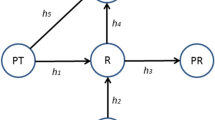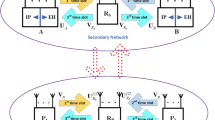Abstract
Current research emphasis on IoT (Internet-of-Things) to enable physical objects to connect, co-ordinate among themselves in a ubiquitous manner. Specifically, for this type of applications, the quality of wireless communication is indeed considered vital to enhance the reliability of battery operated IoT devices. Moreover, these devices operate on unlicensed bands creating heavy congestion on spectrum. Interestingly operating these devices on Cognitive Radio band avoids the spectrum shortage problem by exploiting the dynamic spectrum access capabilities. Cognitive relaying for IoT applications ensures reliable communication through interference mitigation among co-existing IoT devices. In this paper, we therefore propose spectrally efficient two-path decode and amplify relaying technique in three time slots through network-coded co-operation of Primary user and Secondary User. To address the interference issues, optimum power allocation is formulated as a convex optimization problem solved through a modeling system named CVX. Thereby we achieve co-operative diversity without the need for additional antennas for IoT networks. Performance evaluation compares the Bit Error Rate for different relaying schemes with and without optimum power allocation. Our simulation results ensure that the probability of error is minimized and rate is maximized by our proposed algorithm.






Similar content being viewed by others
Data Availability
Data sharing not applicable to this article as no datasets were generated or analysed during the current study.
Code Availability
Code sharing not applicable to this article.
References
Li, Q., Hu, R. Q., Qian, Y., & Wu, G. (2012). Cooperative communications for wireless networks: Techniques and applications in LTE-advanced systems. IEEE Wireless Communications, 19(2), 22–29. https://doi.org/10.1109/MWC.2012.6189409
Laneman, J. N., & Wornell, G. W. (2003). Distributed space-time-coded protocols for exploiting cooperative diversity in wireless networks. IEEE Transactions on Information Theory, 49(10), 2415–2525. https://doi.org/10.1109/TIT.2003.817829
Kamal, M., Ibrahim, M., Mir, S. and Aman, M.N. (2016). Comparison of multihop relaying protocols in cognitive radio networks. In IEEE Sixth International Conference on Innovative Computing Technology (INTECH). (pp. 611–616).
Girnyk, M. (2012). Cooperative communication for multi-user cognitive radio networks. PhD diss. KTH Royal Institute of Technology.
Dai, W., Shen, Y., & Win, M. Z. (2015). Distributed power allocation for cooperative wireless network localization. IEEE Journal on Selected Areas in Communications, 33(1), 28–40. https://doi.org/10.1109/JSAC.2014.2369631
El-Malek, A. H. A., & Zummo, S. A. (2015). A bandwidth-efficient cognitive radio with two-path amplify-and-forward relaying. IEEE Wireless Communications Letters, 4(1), 66–69. https://doi.org/10.1109/LWC.2014.2370034
Lavanya, S., & Bhagyaveni, M. A. (2019). EVM based rate maximized relay selection for cooperative cognitiveradio networks. International Journal of Electronics and Communication (AEU), 104, 86–90.
Shin, S. Y., and Nugraha, T. A. (2013). Cooperative water filling (Coopwf) algorithm for small cell networks. In IEEE International Conference on ICT Convergence (ICTC). (pp. 959–961). https://doi.org/10.1109/ICTC.2013.6675527.
Yu, S. J., Choi, W. J., & Song, H. K. (2015). Efficient decoding scheme for cooperative communication using hierarchical modulation in the mobile communication systems. Wireless Personal Communications, 82(3), 1789–1798. https://doi.org/10.1007/s11277-015-2313-6
Jiang, H., & Wilford, P. A. (2005). A hierarchical modulation for upgrading digital broadcast systems. IEEE Transactions on Broadcasting, 51(2), 223–229. https://doi.org/10.1109/TBC.2005.847619
Vitthaladevuni, P. K., & Alouini, M. S. (2001). BER computation of 4/M-QAM hierarchical constellations. IEEE Transactions on Broadcasting, 47(3), 228–239. https://doi.org/10.1109/11.969372
Luo, C., Gong, Y., and Zheng, F. (2009). Full interference cancellation for two-path cooperative communications. In IEEE WCNC Wireless Communications and Networking Conference. (pp. 1–5).
Ji, Y., Han, C., Wang, A., & Shi, H. (2014). Partial inter-relay interference cancellation in two path successive relay network. IEEE Communications Letters, 18(3), 451–454. https://doi.org/10.1109/LCOMM.2014.011714.140016
Bala Vishnu, J., & Bhagyaveni, M. A. (2021). Opportunistic transmission using hybrid sensing for Cognitive Radio Sensor Network in the presence of smart Primary User Emulation Attack. International Journal of Electronics, 108(7), 1183–1197. https://doi.org/10.1080/00207217.2020.1837254
Digham, F. F., Alouini, M. S., & Simon, M. K. (2007). On the energy detection of unknown signals over fading channels. IEEE Transcommunication, 55(1), 21–24. https://doi.org/10.1109/TCOMM.2006.887483
Bala Vishnu, J., & Bhagyaveni, M. A. (2020). Energy efficient cognitive radio sensor networks with team-based hybrid sensing. Wireless Personal Communication, 111, 929–945. https://doi.org/10.1007/s11277-019-06893-y
Liang, Y. C., Zeng, Y., Peh, E. C. Y., & Hoang, A. T. (2008). Sensing-throughput tradeoff for cognitive radio networks. IEEE Transactions on Wireless Communications, 7(4), 1326–1337. https://doi.org/10.1109/TWC.2008.060869
Ajirak, M., Omidi, M. J., Saeedi-Sourck, H., & Minasian, A. (2017). Optimal power allocation for relay-based cooperative communication systems with energy harvesting. Transactions on Emerging Telecommunications Technologies, 28(8), e3144. https://doi.org/10.1002/ett.3144
Funding
The authors did not receive support from any organization for the submitted work.
Author information
Authors and Affiliations
Contributions
All authors contributed to the study conception and design. Concept preparation and analysis were performed by [Bala Vishnu J], [Lavanya S] and [Bhagyaveni M.A]. The first draft of the manuscript was written by [Lavanya S] and all authors commented on previous versions of the manuscript. All authors read and approved the final manuscript.
Corresponding author
Ethics declarations
Conflict of interest
The authors declare that they have no competing interests.
Additional information
Publisher's Note
Springer Nature remains neutral with regard to jurisdictional claims in published maps and institutional affiliations.
Rights and permissions
About this article
Cite this article
Vishnu, J.B., Lavanya, S. & Bhagyaveni, M.A. Spectrally Efficient Cognitive Relaying for IoT Networks. Wireless Pers Commun 122, 3433–3443 (2022). https://doi.org/10.1007/s11277-021-09093-9
Accepted:
Published:
Issue Date:
DOI: https://doi.org/10.1007/s11277-021-09093-9




